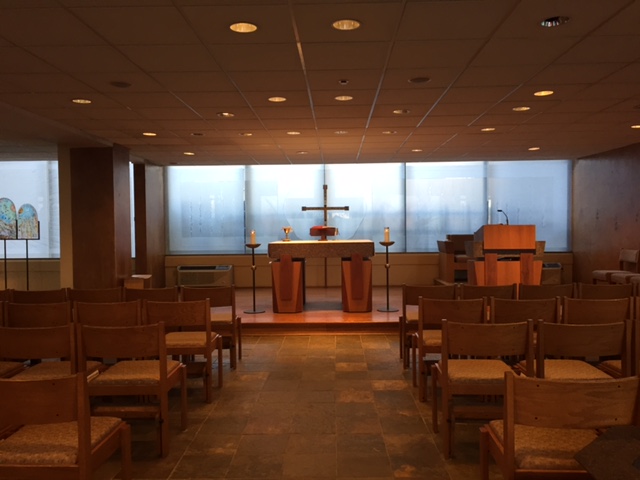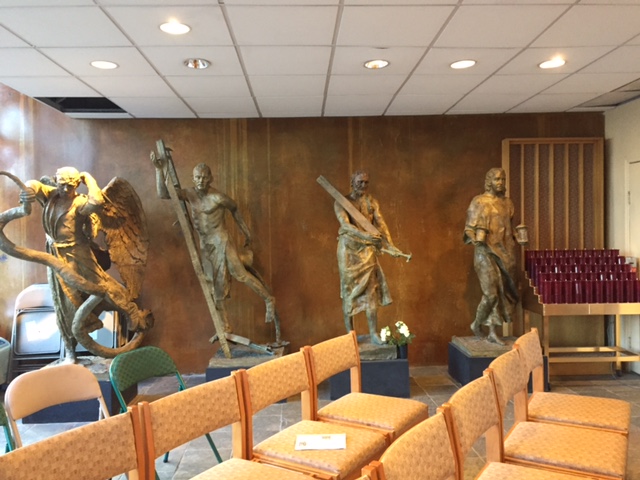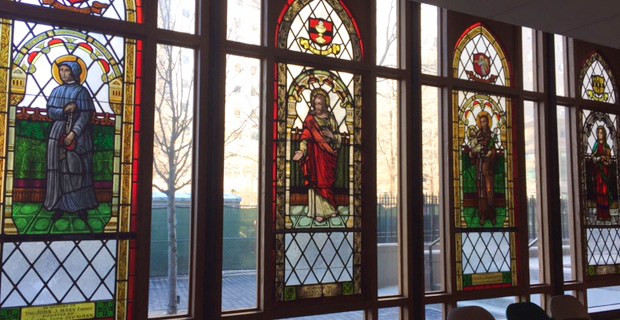In the days after the 9/11 attack, St. Joseph’s Chapel in Manhattan was used as a Federal Emergency Management Agency (FEMA) command station.
First responders tore out the pews to provide a space for food, emergency shelter and trauma counseling during the months of clean-up. Even the altar cloths were torn up and used as bandages.
Following the rescue operations, the chapel became a temporary sanctuary where construction workers, police offers and firefighters came to eat, email their families, talk with spiritual counselors and rest from the grueling reality of Ground Zero.
St. Joseph’s Chapel, which holds just 100 people, is part of the parish of St. Peter and Our Lady of the Rosary, the oldest Catholic parish in NYC, dating to 1785. Mass was celebrated in a nearby gym while the chapel was in use.

The chapel’s interior was devastated by smoke, debris, and the nature of the command center work. After a degree of normalcy resumed, the idea for a Catholic Memorial was proposed. More Catholics than any other faith group perished on 9/11. The parish determined to create a memorial that would look at the terrorist attack from a Catholic perspective, and affirm the belief that life is stronger than death, love is stronger than hate. Dedicated parishioners undertook a total remodeling of the chapel/memorial.
But today, the chapel itself is in danger of being permanently closed down. High rent could force the closure of the chapel unless an agreement is reached or there is miraculous intervention.
Pastor Fr. Jarlath Quinn has said the chapel will have to close by the end of June. The rent has skyrocketed since new buildings and luxury apartments changed the area of Battery Park City from middle class to an upper class neighborhood.
The Archdiocese of New York loaned the parish $540,431 during 2016, bringing the parish net deficit for the year to $91,868 and the parish’s total indebtedness to the Archdiocese to $1,348,000.
Justine Cuccia was nine months pregnant when she witnessed the attack on the World Trade Center. She lived just across the street from St. Joseph’s Chapel.
Cuccia and a group of parishioners, most of whom lived through the 9/11 terrorism, are trying everything to possible to preserve the chapel and memorial.

The group’s first hope is for a compromise on the rent that the archdiocese and landlord can agree on.
“We have asked for the assistance of the Battery Park City Authority,” Cuccia said. “Through their intervention, the landlord offered to reduce the rent from $80 per square foot to $70 per square foot retrospective to January 1, 2017, until the lease ends in March 2019. The Pastor and financial committee maintain that this is still not sustainable and have told us they countered at $17 per square foot.”
With a rental space of 3310 square feet, it’s easy to see why the $70 figure is still too high.
The parish referred questions to Joseph Zwilling, director of communications for the Archdiocese of New York.
The decision “would be a parish decision, as Saint Joseph’s Chapel is a part of Saint Peter’s Parish,” Zwilling told CNA. “The parish is still determining next steps, but at this point it appears as if only some kind of ‘miracle’ would keep the Chapel going.”
Father Quinn is making plans to properly preserve the 9/11 memorial, should Saint Joseph’s Chapel close, Zwilling added.
Parishoners counter that the chapel is the memorial, and any effort to preserve it by relocating the art but vacating the space would miss the point. During the post-9/11 reconstruction, everything that went into the chapel’s interior emphasized hope and resurrection, Cuccia said.
“Everything about the completely renovated site — the wood on the walls, the altar, the windows — was specifically chosen and designed to be a symbol of rebirth, renewal and growth, to say ‘we’re back, we got knocked down after 9/11 and we’re back,'” Cuccia told Aleteia. “The church itself is the memorial. They say a church is made up of the people, and we will be a parish and a church wherever we go, but the 9/11 memorial will cease to exist if it’s not at St. Joseph’s.”
Those seeking intervention include Syrian and Lebanese Catholic groups who have worshiped in the area for generations. The groups appealed to Governor Cuomo, Mayor DeBlasio, the landlord, and Cardinal Dolan, saying that the “closure of the chapel, due to large rent increases of 300%, would represent an unfortunate end to a 130-year history for a church that was founded by the earliest Syrian and Lebanese immigrants to the United States.”
These groups note how “tens of billions of dollars have been spent on large developments projects in the area, yet community institutions and historic buildings continue to be neglected or dismantled due to lack of foresight and organized support.”
Other avenues parishioners are actively pursuing include finding an entity to take over the space as a 9/11 memorial, and opening the space for community use.

